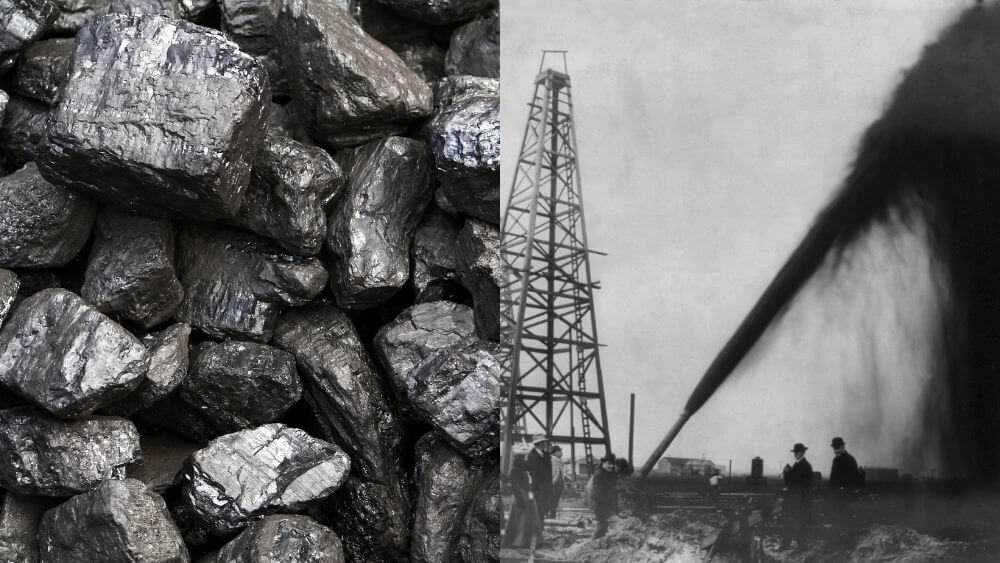Coal and Petroleum

On a daily basis we use various kinds of materials. Some of these are man-made while others are not i.e., they are derived from nature or are natural resources.
Natural Resources can be classified into two types:
Contents
1. Inexhaustible Natural Resources –
These are natural resources that are present in unlimited amounts and cannot be exhausted by human activity. Examples include sunlight, air.
2. Exhaustible Natural Resources –
These are resources which are found in a fixed amount on earth and therefore must be used carefully to prevent complete depletion. Such resources can be exhausted by human activity. Examples include forests, wildlife, minerals, coal, petroleum, natural gas etc.
Let’s take a look at three of the most common exhaustible natural resources : coal, petroleum and natural gas. These are obtained from the decaying remains of living organisms and hence are called fossil fuels.
Fossil Fuel is a fuel that is formed by decomposition of buried dead organisms over millions of years.
1. Coal
- Coal is as hard as stone and is black in colour
- Coal burns in air to mainly release carbon dioxide
- It is used a fuel to generate heat for cooking
- It is used to produce electricity in thermal power plants
- Earlier it was used to produce steam to run railway engines
Formation of Coal:
- 300 million years there were dense forests in the low lying areas of the earth
- Due to natural processes such as flooding, these forests were buried and compressed under the soil
- The temperature rose and these forests were buried deeper and deeper with time
- Due to the high temperature and pressure, the dead plants eventually got converted to coal
- Since the main component of plants is carbon, the process of conversion of buried plants and trees into coal is known as carbonisation.
Processing of coal yields three useful products :
Coke
- Almost pure form of carbon
- Tough, porous and black
- Used in the manufacture of steel and the extraction of many metals
Coal Tar
- Black, thick liquid with an unpleasant smell
- Mixture of about 200 substances
- Products obtained from coal tar are used for manufacturing substances such as drugs, synthetic dyes, explosives, perfumes, plastics, paints, photographic materials, roofing materials, etc.
- Naphthalene balls are obtained from coal tar
- Earlier coal tar was used for surfacing of roads but now the more suitable bitumen is used
Coal Gas
- Coal gas is obtained during the processing of coal to obtain coke
- It was used for street lighting in the 1800s; it is more commonly used a source of heat than light now
- It is used as a fuel in industries close to coal processing plants
2. Petroleum
- Used as a fuel for light automobiles such as motorcycles, scooters and cars
Formation of petroleum:
- The word petroleum is derived from the words petra(rock) and oleum(oil) as it is mined from between rocks under the Earth.
- As organisms die at sea, their bodies settle at the bottom and are gradually covered by layers of sand and clay
- In the absence of air, these are organisms are compressed under high pressure and temperature over millions of years and are transformed into petroleum and natural gas
- In India, oil is found in Assam, Gujarat, Mumbai High and in the river basins of Godavari and Krishna
Refining Petroleum:
- Petroleum is a dark, oily liquid with an unpleasant odour
- It is a mixture of various materials such as petroleum gas, petrol, diesel, lubricating oil, paraffin wax, etc.
- The process of separating the constituents of petroleum is known as refining and is carried out in a petroleum refinery.
Constituents of Petroleum and their Uses :
| 1. | Liquid Petroleum Gas (LPG) | Used as fuel in homes and industries |
| 2. | Petrol | Fuel for light automobiles, solvent for dry cleaning |
| 3. | Kerosene | Fuel for stoves, lamps and jet aircrafts |
| 4. | Diesel | Fuel for heavy motor vehicles, electric generators |
| 5. | Lubricating Oil | Used for lubrication |
| 6. | Paraffin Wax | Used in ointments, vaseline, candles. etc. |
| 7. | Bitumen | Used for road surfacing and in paints. |
3. Natural Gas
- It is an important fossil fuel as it can be easily transported through pipes
- It is stored under high pressure as compressed natural gas (CNG)
- It is increasingly being used as a fuel for transport as it produces far lesser amount of harmful gases as compared to petrol and diesel
- It is used as a starting material for production of various chemicals and fertilisers
- In India, natural gas is found in Tripura, Rajasthan, Maharashtra and in the Krishna Godavari delta
Drawbacks of Using Exhaustible Natural Resources:
- Coal, petroleum and natural gas are all fossil fuels that require millions of years for their generation while the reserves we have will only last a couple of hundred years.
- These resources are therefore exhaustible.
- Burning of these fuels generate huge amounts of carbon dioxide and therefore are a major of source of pollution and global warming
- Because of the above reasons, it is advised to use these resources scarcely and only when absolutely essential.
In India, the Petroleum Conservation Research Association (PCRA) advises people how to save petrol/diesel while driving. Their tips are:
- Drive at a constant and moderate speed as far as possible
- Switch off the engine at traffic lights or when idle
- Check to make sure the tyre pressure is correct
- Invest in regular maintenance of the vehicle
Summary:
- Natural Resources
- Exhaustible and Inexhaustible Natural Resources
- Fossil Fuel
- Coal
- Processed products of coal
- Petroleum
- Constituents of Petroleum and their Uses
- Natural gas
- Drawbacks of using natural resources
- PCRA Advisory






Responses